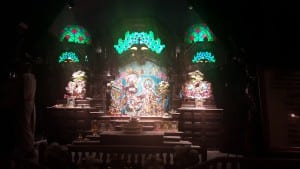I walked into what appeared to be a small church in the middle of a Dallas suburb, however Kalachandji Mandir was much more than that. Located in a neighborhood, we walked into wooden floors with a gift shop on one side of us and a restaurant ahead. After removing our shoes, our guide walked us into the main room of attraction.
The walls were covered with beautiful canvas paintings, each telling a different tale of Krishna. Some depicting Krishna in her youth and others representing her adulthood. The visuals these paintings depicted were absolutely stunning. Each painting however, was more than just a painting or a story, they were life lessons, or life realizations showing that Krishna was relatable to humans, relatable to her followers. Regular attendees also walked around in awe, paying their respect. Clearly being outsiders, we were approached with kindness inquiring about why we were in attendance. No push towards Krishna, or apparent irritableness for us being there, only welcoming smiles.
In the picture shown, rituals and food givings were performed. As probably the most beautiful aspect of the room, it only made sense that it was designed for contact with the higher being. During our time at Kalachandji Mandir we witnessed a gathering and singing of song. It was uplifting to see all these people from different backgrounds gathered for the same purpose singing together in unity.
Outside of the aesthetics of the facility, what interested me the most was the variety of people from different walks of life that entered to pay honor to the same entity. I wasn’t quite sure what to expect in regards to the types of persons that would be in attendance. To my surprise however this anticipation was far from reality. I won’t go into detail about the differences in the persons in attendance, however scanning from one end of the room to the other you would be able to see a broad spectrum of culture. This cultural diversity however makes sense. In reading ‘The Hare Krishna Movement’, it became understood that “the movement was drawing followers from every race and religion” (pg. 181).
The variety of people and the universality of Krishna was very evident at Kalachandji Mandir. In the article ‘The Hare Krishna Movement’ the author compares the survival of ISKCON (The International Society for Krishna Consciousness) to that of Christianity. Through the test of time, ISKCON has “had to find ways to maintain ties to its origins while shaping a new identity to meet new religious needs” (pg. 188). The elasticity of ISKCON has allowed it to survive for so many years and co-exist across so many cultures. This was clearly evident in our brief time there.
In talking with our guide, Kalachandji Mandir is always open for new members. They host a meditation class every Wednesday and Friday. Never practicing meditation before, I asked for more details and plan to start attending these sessions. Who knows, maybe I’ll be attending Kalachandji Mandir and adding even more to the diversity that falls under ISKCON.


